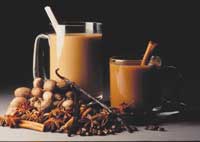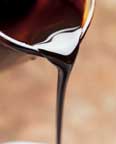
According to Beverage Marketing Corp., ready-to-drink coffee beverages are one of the fastest growing beverage categories. In fact, from 2000 to 2001, Beverage Marketing Corp. estimates this new age beverage segment grew 23.1%.
The National Coffee Assn.'s 2001 National Coffee Drinking Trends survey found iced coffee, which usually contains milk or cream and sweetener, is mostly consumed by 18- to 24-year-olds. In fact, the survey says this group consumes iced coffee twice as much as any other age group.
“We have seen that the daily consumption of coffee is increasing among young adults who are being exposed to the coffee experience,” says William Luttrell, vice president, research & development for Morningstar Foods, a subsidiary of Dallas-based Dean Foods Co., which recently launched the refrigerated extended shelflife (ESL) coffee-milk beverage line Folgers Jakada. “There has been a 25% increase in the number of 18-24 years olds who are discovering sweeter, milkier, coffee-tasting products. This demographic is not about 'taking a coffee break.' They connect with brands that are invigorating and contemporary.”
Of the 107 million daily coffee drinkers, the National Coffee Assn. found there were two million daily drinkers of iced coffee beverages, an additional six million weekly drinkers and another 41 million occasional drinkers, all of whom have no preference to the time of day they drink the beverage. Indeed, chilling coffee and adding a significant amount of milk and sweetener has transformed coffee from a morning pick-me-up drink to an any-time-of-day beverage.
Got Coffee?
Dairy marketers can either wait for Starbucks shops to invade their distribution regions, providing coffee-craving consumers with over-priced, made-to-order, coffee-milk drinks, or they can get busy in the lab.“Local dairy manufacturers have an opportunity to compete in the cold-milk section with bottles and cartons of cappuccino at much lower retail prices than Starbucks products,” says Crandall.
After all, even Starbucks recognizes there is a large group of consumers who don't have easy access to a Starbucks shop, which is why the company also markets shelf-stable beverages through retail outlets for grab-and-go drinking and pantry stocking. In fact, the glass bottle retail Frappuccino line is a $400 million business for Starbucks. It's such a profitable business that the company rolled out in March a canned espresso product called DoubleShot, which contains nonfat milk and cream.
Morningstar's Folgers Jakada is the first chilled coffee beverage to be sold in single-serve HDPE plastic bottles. “As of today, these products are ESL, but we hope to be aseptic in the near future by using manufacturing methods that are approved by the FDA,” says Luttrell.
Being shelf-stable helps expand distribution. Being in plastic makes the package more user friendly.

Formulation Hurdles
“The primary issue in formulating a product containing both coffee and milk is maintaining the physical stability of the product over its shelflife,” says Luttrell. “Because coffee is somewhat acidic it can have an impact on the stability of the milk protein component. There is also the issue of preventing separation of the butterfat component during storage. The appropriate stabilizer systems and buffers must be incorporated without negatively impacting the flavor of the finished product.“Coffee ingredients can be added to milk products in any number of ways using equipment and methods common in the dairy industry,” adds Luttrell. “The key is identifying the proper order of ingredient addition during batching to ensure product stability over shelflife.”
Noreen Carroll, director for food ingredient sales with a Rhode Island coffee ingredient supplier, says, “Coffee extracts tend to be easier to work with than coffee powders. However, whichever is used, the coffee ingredient should be added to the milk prior to pasteurization.
“Coffee extract usage levels depend on the concentration of the extract, but it is usually between 1 and 3% by weight,” she adds. “With powders you typically need a bit more, and the flavor does not usually have a fresh brewed note. However, this is dependent on the type of powder.”
Crandall confirms, “Coffee extract requires lower usage levels than coffee powder, typically, less than 100mls in a gallon of cappuccino milk. This significantly reduces the overall dilution of milk during production.
“Powdered coffee often contributes an 'instant coffee' flavor to milk-based beverages,” he adds. “Liquid coffee extracts obtained directly from roasted and ground coffee beans provide strong aroma, clean coffee taste and appropriate acid levels. Extracts also do not precipitate out of solution like powders tend to do. And they don't contribute any dusting in the plant to impact air ventilation requirements.”
The advantage to using coffee powder is that “The solids provide texture and mouthfeel to the beverage,” according to Joseph Minella, beverage applications manager with a Brooklyn, N.Y.-based flavor house. “When you use a coffee powder, you want to use a coffee flavor to provide coffee top notes. You can also add other flavors at the same time, such as hazelnut, vanilla and chocolate.
“Flavors that complement coffee tend to come from the brown or sweet category,” he adds. “There has been a great deal of activity with caramel flavors to create 'dulce de leche' coffee-milk drinks.”
Lisa Taake, applications manager with a Kansas-based supplier says, “Basically, when developing new flavors [for coffee drinks], we look at it from several angles. In addition to brainstorming and screening hundreds of flavor ideas, we perform stringent analysis of our flavors.”
Flavors need to give a positive organoleptic impression. “They can be engineered to take off the harsh bitter edge inherent to coffee,” Taake says. “They must also be heat-stable and shelf-stable.” New fun flavors for coffee-milk drinks include Homemade Vanilla Ice Cream, Peanut Butter Cookie, S'more and Caramel Corn.
“Also, if you are formulating a lower-fat coffee-milk beverage, you can add dairy and cream flavors to balance the flavor profile. You get the rich flavor without the calories,” Minella adds.
An Added Perk
Starbucks' DoubleShot, which is targeted to a slightly older demographic than the 18 to 24 crowd, comes in a 6.5-oz can and is positioned as a chilled morning beverage to kick-start the day.The caffeine content of coffee is the added perk dairy processors have to compete in the functional beverage category.
This article first appeared in the June 2002 issue of Dairy Foods, a sister publication of Prepared Foods.
Website Resources
www.starbucks.com— Starbuckswww.ncausa.org— National Coffee Association
www.beveragemarketing.com— Beverage Marketing Corp.
www.morningstarfoods.com— Morningstar Foods